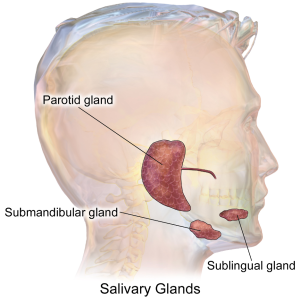Oral Secretion and Saliva
Saliva is produced by the salivary glands in the oral cavity and distributed through tubes called ducts. Saliva is mostly water, but also contains small amounts of minerals and enzymes. The presence of saliva keeps oral bacteria low and lubricates food for mastication and transportation. Furthermore, the enzymes contained in the saliva aid in the break down of food.
Clinical Note
Xerostomia or dry mouth can alter bolus formation and swallow function. A common cause of xerostomia is medication. Drugs that can cause xerostomia include: antihistamines, decongestants, antidepressants, anticholinergics, anorexiants, anti-anxiety agents, antihypertensives, antipsychotics, anti-Parkinson agents, diuretics, bronchodialators, muscle relaxers and sedatives. The drying effect of these meds is typically only problematic during the life of the medication in the system.
Clinical Note
Reduced oral saliva results in increased bacteria in the oral cavity. If this material is aspirated these bacteria are introduced to the delicate lung tissue increasing the risk of pneumonia (Langmore et al., 1998).
While there are many salivary glands, we will focus on the three major paired glands—parotid glands, submandibular glands, and sublingual glands (Box 1.31). The parotid gland is the largest of the salivary glands and is located in the parotid space from the ramus of the mandible to the ear. It secretes saliva via the parotid duct into the oral cavity to assist in bolus development during mastication. It produces serous (thin) fluid. The submandibular glands are located below the floor of the mouth. Saliva is secreted to the floor of the mouth via the submandibular duct. These glands produce both serous and mucus fluid. The sublingual glands lie anterior to the submandibular glands. There are multiple ducts that connect to these glands and distribute the saliva. These glands primarily produce mucus. In a healthy adult, saliva glands produce about 2 to 4 pints of saliva per day with most of that in the late afternoon. Saliva production is lowest at night.
Box 1.31: Salivary glands

At times individuals may produce too much or too little saliva, or saliva may become more viscous. Changes in the viscosity of saliva, or reductions in saliva production are not only a function of the gland, but may also indicate changes in health or reflect medications being consumed by the individual.
The sublingual and submandibular glands are innervated by CN VII. The parotid glands are innervated by CN IX. These glands are under the domain of the autonomic nervous system and have their own nuclei— superior salivary nucleus in the pons and the inferior salivary nucleus in the medulla. Thus, saliva glands are typically not impacted by hemispheric stroke. Further, damage to the motor nuclei of VII or IX will not alter salivary production.

